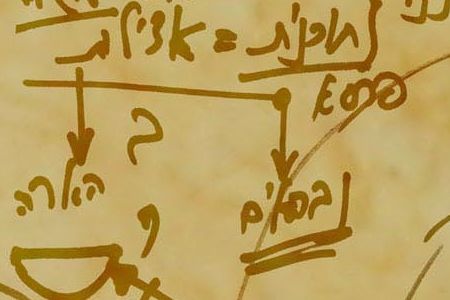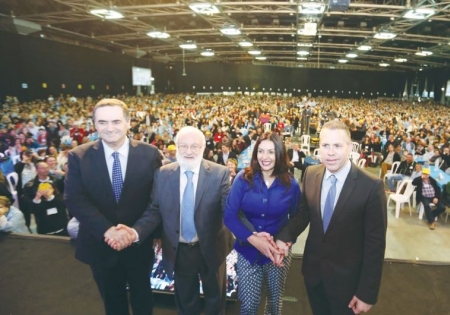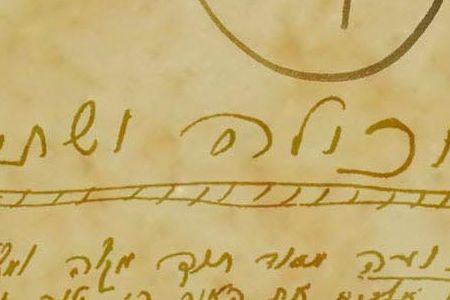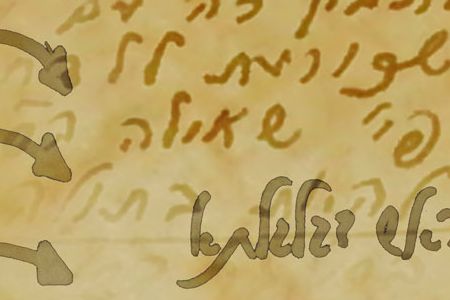Exodus, 35:1-38:20, 38:21-40:38
This Week’s Torah Portion | February 28 – March 5, 2016 – 19 Adar I – 25 Adar I, 5776 |
March 6 – March 12, 2016 – 26 Adar I – 2 Adar II, 5776
In A Nutshell
The portion, VaYakhel (And Moses Assembled), begins with the commandment, “Six days shall work be done, but on the seventh day there shall be to you a holy day” (Exodus, 35:2). The portion also deals with the donation of the people. The donation is in gold, silver, copper, precious fabrics, and so forth. Moses determines that Bezalel and Ahaliav will be the ones performing the holy work because they were wisehearted and would collect the donation that came from the entire nation, including the women.
Bezalel and Ahaliav tell Moses that the donations are so voluminous that there is surplus and no need for more. Moses declares this to the people.
The portion elaborates on the building of the tabernacle by the wisehearted: the garments, boards, bolts, and Bezalel’s work preparing the Ark (of the Covenant), the table, and the menorah.
The portion, Pekudei (Accounts), mentions the names of the people who took part in building the tabernacle, Itamar, son of Aaron the priest, Bezalel, son of Uri, and Ahaliav, son of Ahisemech.
As the building of the tabernacle concluded, the children of Israel brought it to Moses, who made sure it was done according to the Creator’s commandment. The Creator tells Moses on which day to establish the tabernacle, and by which order to sanctify each of its elements. He also commands Moses to anoint Aaron and his sons as priests.
The end of the portion tells of the cloud that covers the tent of meeting. Each time the cloud rose above the tabernacle the children of Israel traveled, and each time it descended on the tabernacle they parked.

Commentary by Dr. Michael Laitman
Both portions present a sequence of one topic. The Torah begins with “I have created the evil inclination; I have created for it the Torah as a spice.”[1] The evil inclination is our entire nature manifesting in our hatred for one another. First we must discover it, hence the first revelation of the evil inclination takes place with Abraham in the Tower of Babylon. Subsequently, we discover it in the hard labor in Egypt, then at the foot of Mount Sinai, where hatred prevailed between everyone, as it is written, “Hatred descended to the nations of the world.”[2] This is the recognition of evil.
It is no simple task to know the evil. It does not concern discovering that one is lazy or deceitful, thieving, or exploitive. Rather, the evil appears only when a person wants to unite with others. It happens only among those who are drawn to connection, to “love your neighbor as yourself.”[3] When they try, nature does not let them bond.
According to the Torah, which is the upper force, if one truly wishes to achieve love of others, and through it the love of the Creator—which is the comprehensive love—and wants to discover the common, benevolent force that prevails in the world, all that one needs is the Torah.
Today it may seem to us that the world is terrible because we are examining it through our evil inclination, through our corrupted qualities. But “All who cast fault, cast fault in his own defect.”[4] As we correct ourselves we become righteous and justify the Creator and His creation. Then we begin to see the world as good. Baal HaSulam describes it in his essay, “Concealment and Revelation of the Creator’s Face.”[5]
One who begins to connect with others and love them, who draws closer to the global and integral world—as we discover it to be each day, hence the current surfacing of the wisdom of Kabbalah—begins to feel the evil. Then, and only then does one need the Torah, for it is the “light that reforms.”[6]
The Torah has nothing to do with a person studying the text in the book. Rather, it is about one who studies in order to receive the light that corrects, to acquire more and more love for the world. In this manner we become more and more similar to the Creator, thus returning to the image of man, called Adam. The part we attain and correct over our evil inclination, the part that turns the evil inclination into a good inclination is called a “soul.”
This is why we take from Egypt the primary Kelim (vessels), which are valuable in the eyes of the great evil inclination, and through which we emerge from the period known as “Egypt” and enter the recognition of the evil inclination, building from them the golden calf. When everything appears clearly and intensely, we truly need the Torah.
This is the reason why the first tablets where inappropriate for correction, but only the second tablets, with which Moses descended on the Day of Atonement and brought them to the people of Israel, once the people recognized the evil in them. We know the evil in us and need the Torah only after we see the golden calf within us and how we resist love of others and want to exploit the entire world.
The Torah explains the stages of building of the tabernacle—which desires out of the sum of evil desires we have toward others do we correct from receiving into giving, from hate to love. This is the whole Torah, the instruction how to do this. Instead of being immersed in our evil inclination, seeing only the narrow reality of this world, if we correct our desires even slightly we can open ourselves to see the upper world, here and now.
As we develop in this manner, the world around us opens and appears as the world of Assiya, Yetzira, Beria, Atzilut, and Adam Kadmon—the world of Ein Sof (infinity)—at the end of correction. First, we build a small Neshama (soul) that is common for all. This is the “tent of meeting, which includes the still, vegetative, animate, and speaking, which is our quality, the Yod–Hey–Vav–Hey, the complete HaVaYaH within us. We must take from each desire and connect everything into a single, integral desire that is common to all, and which will connect to all the people who are ready for it, building together a united, common Kli (vessel). This is how everyone advances.
A person must have the qualities of Bezalel, of a priest, Aaron the priest, and certainly those of Moses—the first of the priests, Levites, and Israel. The Torah explains how we can use the light that we draw in order to understand which desire we can correct now, and which we can correct later.
As Moses said in the previous portion, only half of the desires were corrected using the half shekel, the shekel of the holiness. The other half comes from above. The half is our deficiency, and the other half is the light that corrects and complements. With our efforts we build everything that depends on us, all the qualities of the soul: priests, Levites, and Israel, using silver, gold, and various precious stones.
Through the mind and heart that only the qualities of Bezalel have, as it is a replication from the Creator, we feel that we have an example by which to build our soul in accord with the Creator who appears before us. This is how we build the soul in which we experience the new world, which is the Kli, our corrected desire. Within that desire is the force of bestowal and love called Boreh (the Creator), Bo Re’eh (come see). This is how we come to see, discover the Creator.
The first steps alternate in appearance between cloud and fire, as the Creator ascending and descending. “Rise up, O Lord, let Your enemies be scattered, and let those who hate You flee before You” (Numbers, 10:35). In our current situation, in our world, we cannot talk about these things or about the parts we need to correct because we still have no sensation of our soul; we do not find these desires in us or know quite how to scrutinize them or connect them in this extremely complex system. The Torah tells us this as a story that is a replication from this world: rocks, trees, people, clothes, the world in general, time, motion, and place. These forms are described so we may discern which parts of the soul we must correct.
Within the soul are forces that work in order to receive, and must be turned into working in order to bestow. We still cannot express these forces and name them because we do not know them, so the Torah tells us the story in its own way, and Kabbalists convey it in the “language of roots and branches.”
Kabbalists tell us about the forces that operate, about the parts of the soul. The Book of Zohar with the Sulam (Ladder) commentary that Baal HaSulam wrote narrates it in the language of Kabbalah, so we can understand what is meant by the words of the Torah. We can understand that the Torah speaks only of the parts of our soul, the correction of the heart, which is our desires. In this manner we can unravel the entire Torah, discover it in our hearts as a corrected system, and discover the upper force, the Creator, within all that.
Questions and Answers
What does it mean to gather?
Gathering refers to the children of Israel that Moses assembles in order to declare the Sabbath day, which is the conclusion of the work. The goal must be clear from the start because “the end of an act is in the preliminary thought.”[7] If we know why we must achieve Dvekut (adhesion) with the Creator, why we must make ourselves similar, discover Him, and be like Him, literally “face to face,” namely be in Moses’ degree, we must know it in advance. Even in the smallest action, there must be the same goal, the same clear line drawn out and compelling us to advance only in this direction. Whatever problems arise along the way, ascents, descents, and twists, they will all be for progressing.
This is why in the desert that Israel traverse there is constant recognition of the evil, and it is actually for the best. Additional desires keep surfacing and we must correct them in order to advance toward the land of Israel—the corrected desire where the Creator resides.
Why do we have to know all the details by which we advance, these ascents and descents?
This is how we attain the plan of creation, its purpose, the understanding, sensation, and knowledge of it. There is a difference between the will to receive that the Creator created existence from absence in the beginning of creation, and the will to receive at the end of creation. At the end of creation that desire has a mind. It remains the same will to receive, but with a mind, comprehension, recognition, and sensation. Everything comes from the connection of mind and heart.
Will a person necessarily experience all the elements described in this portion?
A person will not experience it without planning to, without desiring to participate, without raising MAN and requesting to correct. Only one who wants, feels, and is aware of how much he or she hates but wants to love will experience everything. Therefore, we must correct some of the still in us, some of the vegetative, and thus discover the reality we are in, and from it reveal the other reality.
Gradually, we become a structure that contains all the mind and heart, all the wisdom in the world. The whole of nature is within us and we include all the worlds. There is nothing outside of us. The vast world we depict outside of us does not exist; it is only depicted in this manner in our external Kelim, which must all be made internal. Hence, there is nothing but man and the Creator who are as a single system.
From The Zohar: Whoever Is of a Generous Heart, Let Him Bring It
“Take from among you a donation.” When a person places his will for the work of his Master, that will first rises to the heart—the persistence and the basis of the entire body. Afterwards that good will rises over all the organs of the body, the will of all the organs of the body and the will of the heart join together, pulling over them the brightness of Divinity to dwell with them. And that person is the Creator’s portion, as it is written, “Take from among you a donation.” “From among you” is the extension, to take upon yourselves that donation, the Divinity, so that the person will be a portion of the Creator.
Zohar for All, VaYakhel (And Moses Assembled), item 71
Initially, there is an egoistic desire that a person corrects by donation. The donation is the part of the will to receive with which one can enhance the quality of bestowal. The donation raises the part of bestowal with which one wants to dominate and advance.
By donations that we put aside from the ego, namely parts we can sanctify and invert how we use them into bestowal and love, we advance up to the end of correction. At that time it is not building a tabernacle or advancing in the tabernacle in time, place, and motion. Rather, it is reaching Mount Moriah and building the Temple.
Kabbalists attain the complete structure, the complete soul, called Beit HaMikdash (House of Holiness, Temple). In it are all the parts: priest, Levite, Israel, and the nations of the world. The great Kabbalist, Ramchal, Rabbi Moshe Chaim Lozzato, wrote a special essay known as “The Dwelling Place of the Most High,” in which he drew in great detail what the third Temple should look like. He did not refer to the rocks in Jerusalem, but to the structure of the corrected soul, which must eventually be on the Sabbath, as was said at the beginning of the portion. We arrive at the Sabbath upon the conclusion of the six days, or six thousand years, when all the Kelim are corrected and there is nothing more to do or to work with but to enjoy in happiness and peace.
When the children of Israel bring donations, Moses says, “That’s enough, you’ve gone too far.” It sounds odd because we say that there are no limits on bestowal.
True, but each degree has its own scrutiny. The soul consists of three parts: NHY, HGT, HBD, or Ibur (conception), Yenika (nursing), and Mochin (mindfulness/adulthood), or Nefesh, Ruach, Neshama. Neshama is named after the great light that can be in it.
Hence, on the degree of Israel they give a lot; on the degree of Levites they give less; and on the degree of priests they give even less. It depends on a person’s degree and on who is performing the scrutiny.
It also depends on the degree to which a person raises the desires. If the person stays in desires of the Israel degree, whatever one brings is fine. But when the desires are at the level of Levites or priests, we haven’t enough forces to be in such a high degree with all of our desires, so they are restricted. This is the meaning of the degrees in the soul.
If the Creator gives to us and then says, “Give it back,” why did He give it in the first place?
The Creator created an entire world, the world of Ein Sof, then broke it and gave us a broken world and a broken Adam (soul) so we may fix it. It is similar to a puzzle or LEGO bricks that we put together and learn as we advance. If we give this game to a child without putting it together, the child will break it because children are driven by the urge to understand and know. By nature, we cannot approach a complete thing. To understand it, study it, we must have it broken.
How does all that connect to donations?
We take our broken desires and raise them as high as we can toward correction, and the correction comes from above. The Creator has given us everything broken; we need only raise that corruption, meaning recognize it, and ask Him to partake in the correction. The correction itself always comes from above through the light that reforms, as it is written, “I have created the evil inclination; I have created for it the Torah as a spice … because the light in it reforms.”[8]
We are in the middle. We do not belong to the evil inclination; it is not our own because in truth, the Creator has made it and given it. We also do not belong to the light that reforms. Our job is only to connect the two: the corrupt desire below with the light from above. That is, all we need is to ask, demand, and pray for correction.
How do we do it properly? How should we prepare this work so that we bring it to the Creator in the right way?
Our work is to sort each desire whose time has come. First we scrutinize it through the light, then set it up for correction through the light and ask for correction. These things can happen only by the light that shines, so without studying the wisdom of Kabbalah it is impossible to do anything, as this is what brings the light.
Do we receive the light when we study Kabbalah?
Yes. During the study a person begins to feel how everything falls into place. If the study is done properly, it takes some time for one to actually achieve it, but then one can study the Bible, the Pentateuch, Gemarah, and Mishnah and they will all be a source of light to that person.
From The Zohar: These Are the Accounts of the Tabernacle
And as the desire of all of Israel was in what they volunteered, so was their desire in that calculation. By their desire, they extended the Mochin of calculation, and then the whole work was done by desire. Hence, calculation is needed here in the tabernacle, since by calculation is the work done. This is why it is written, “These are the accounts of the tabernacle.”
It is a calculation that faults all the calculations in the world—extension of GAR de Hochma—which are not of Kedusha [holiness], for they do not persist, but destroy the place to which they are drawn. Yet, this calculation in the tabernacle, which is VAK de Hochma, persists more than all the others, and by that the tabernacle persists, and not by another.
Zohar for All, Pekudei (Accounts), item 49
There is a big difference between VAK and GAR. GAR means we are drawing by ourselves; VAK means that we are rejecting, that everything is done in bestowal. The lights are all passing through us; we are receiving the full Ein Sof in order to convey it to everyone. But we are not harmed when we work entirely in order to bestow, thus making ourselves similar to the source, the Creator. He passes through Him to everyone, and likewise, when we all connect, passing from everyone to everyone, the great sphere called “the common soul of Ein Sof” is made.
[1] Babylonian Talmud, Masechet Kidushin, 30b.
[2] Midrash Rabah, Shemot (Exodus), Portion 2, Paragraph 4.
[3] Jerusalem Talmud, Seder Nashim, Masechet Nedarim, Chapter 9, p 30b.
[4] Babylonian Talmud, Masechet Kidushin, p 70a.
[5] The Writings of Baal HaSulam, p 766.
[6] Midrash Rabah, Eicha, “Introduction,” Paragraph 2
[7] Lecha Doddi, Elkabetz, sung on Sabbath Evening
[8] Babylonian Talmud, Masechet Kidushin, 30b; Midrash Rabah, Eicha, “Introduction,” Paragraph 2.



